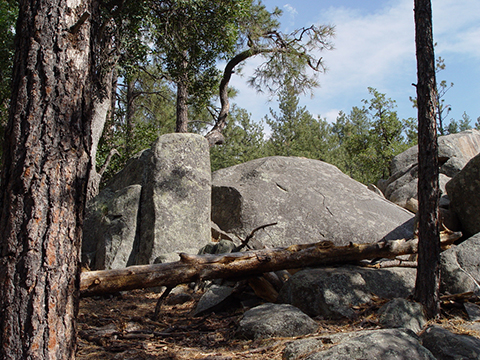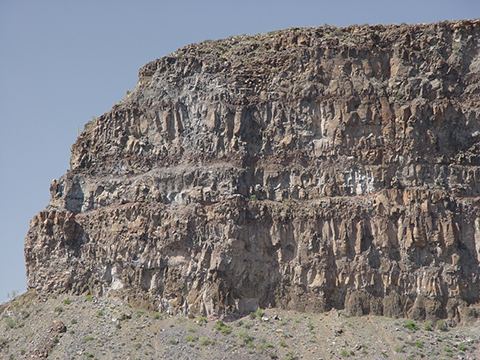Prelude
Igneous rocks are part of a group of rocks that form from molten liquid rock or magma. When the magma crystallizes beneath the surface, the rock that forms is called plutonic (or intrusive) rock. When magma cools and solidifies on the surface, the resulting rock is called volcanic (or extrusive) rock.
|
Figure 4-1. Plutonic and volcanic igneous rocks are exposed all over Arizona. Rounded granitic outcrops in the Prescott National Forest (left) and basaltic cliffs of the Agua Fria National Monument (right). Remember to click on the highlighted images to see larger versions. |
|
Magma originates from shallow depths (a few kilometers) to very deep (below 100 km) and since it is typically more bouyant than the surrounding rock, it rises toward the surface. Commonly, the ascent stops before reaching the surface and the magma crystallizes to form a plutonic rock in subterranean magma chambers of various shapes that are termed plutons or intrusions. Plutons have a wide range of size and shape, from relatively thin and sheet-like dikes and sills to larger stocks and batholiths. Since magma is insulated by the surrounding wall rock, it loses its heat rather slowly. Depending on the composition of the magma, certain minerals will start to form (crystallize) at a few starting points (called nucleation points) and slowly grow into larger, interlocking crystals that are big enough to see without a microscope.Plutonic rocks eventually form as each type of mineral crystallizes over a range of temperatures, with the first crystals forming at higher tempertures, followed by others at progressively lower temperatures until all the liguid magma (sometimes called melt) is gone. All this happens deep within the Earth, but we know what happens from experimental laboratory studies.
Volcanic rocks, like their plutonic relatives, are igneous rocks that originally form from molten liquid rock or magma. When magma cools and solidifies on the surface, the resulting rock is called volcanic (or extrusive). Magmas originate from shallow crustal levels (a few kilometers) to deep within the mantle (100 kilometers or more). These magmas are well insulated by the surrounding wall rock, so lose their heat rather slowly where they may crystallize to form a plutonic rock. Due to their positive buouyancy, they may also keep rising toward the surface through conduits, pipes, or fissures, occasionally pausing along the way. Some crystallization may occur during the ascent, producing crystals that are big enough to see without a microscope. Magma erupts onto the surface (and is called lava) with many different and distinct styles, producing an assortment of volcanic rock types and structures. Depending on various factors (like magma composition, the presence of gas or water in the magma, etc.), magmas erupt quietly as lava flows or violently and are blown into pieces. As with plutonic rocks, certain minerals may start to form (crystallize) as the magma cools. Each type of mineral crystallizes over a range of temperatures, with the first crystals forming at higher tempertures, followed by others at progressively lower temperatures until all the liguid magma (sometimes called melt) is gone. The difference is the rate of crystallization on the surface is much faster, so the resulting crystals are much smaller. Sometimes the lavas cool so fast that they form volcanic glass (with no crystals) or erupt so violently that they are blown into ash-sized particles. All this happens on/near the surface of the Earth, and we observe many volcanic processes first-hand. Volcanic rocks and structures can that tell us about volcanic eruptions of the past.
What Will You Do Today?
A. Igneous Rock Composition & Texture - Review the different kinds of igneous compositions and textures
B. Identifying & Interpreting Igneous Rocks and Structures - Identify and interpret different kinds of plutonic and volcanic igneous rocks and structures
C. Igneous Rocks in Geologic Maps - Read geologic maps that include different types of igneous rocks
D. Geology of Agua Fria Canyon - Learn about different intrusive structures and solve a sequence diagram that is full of igneous features


